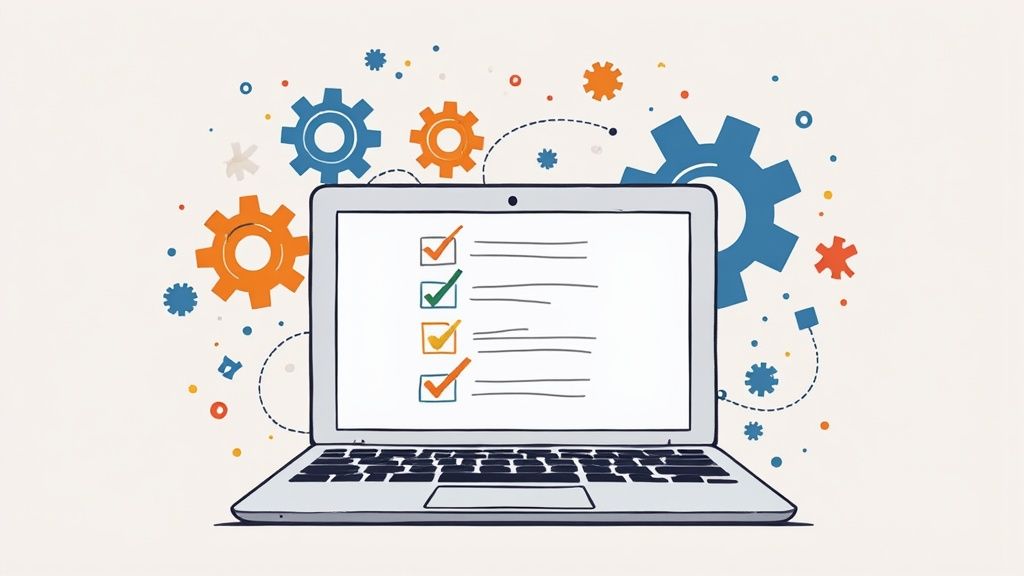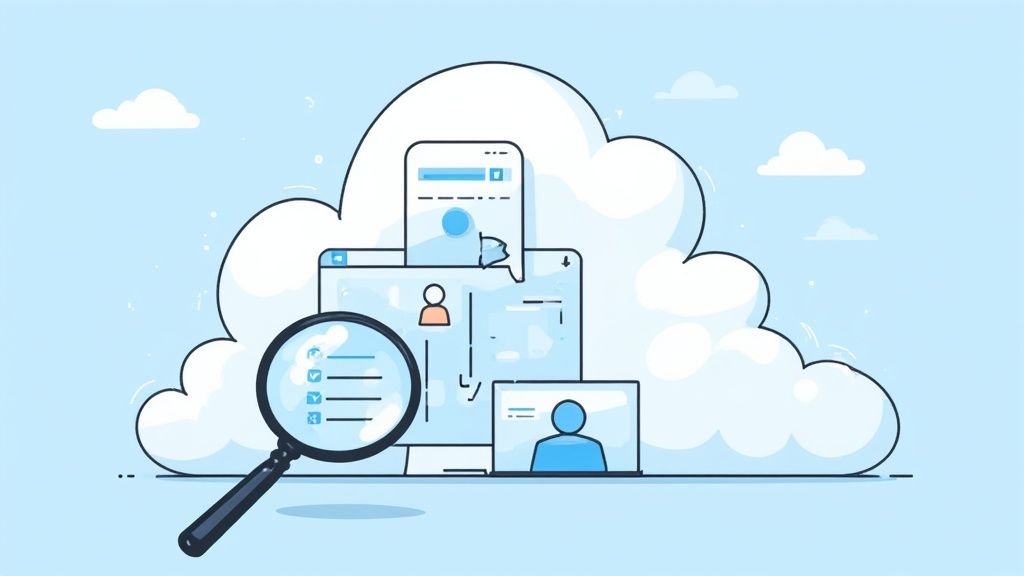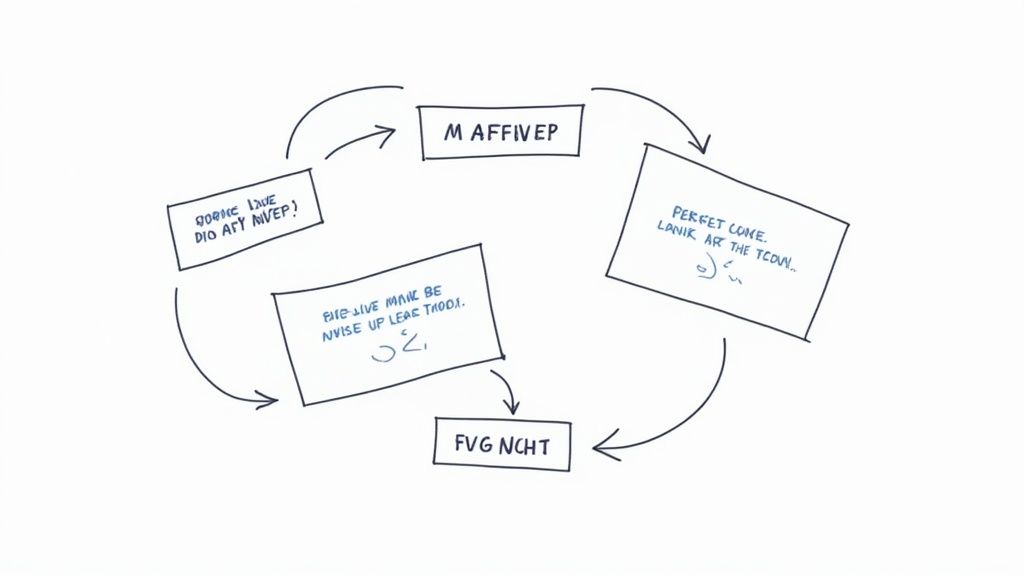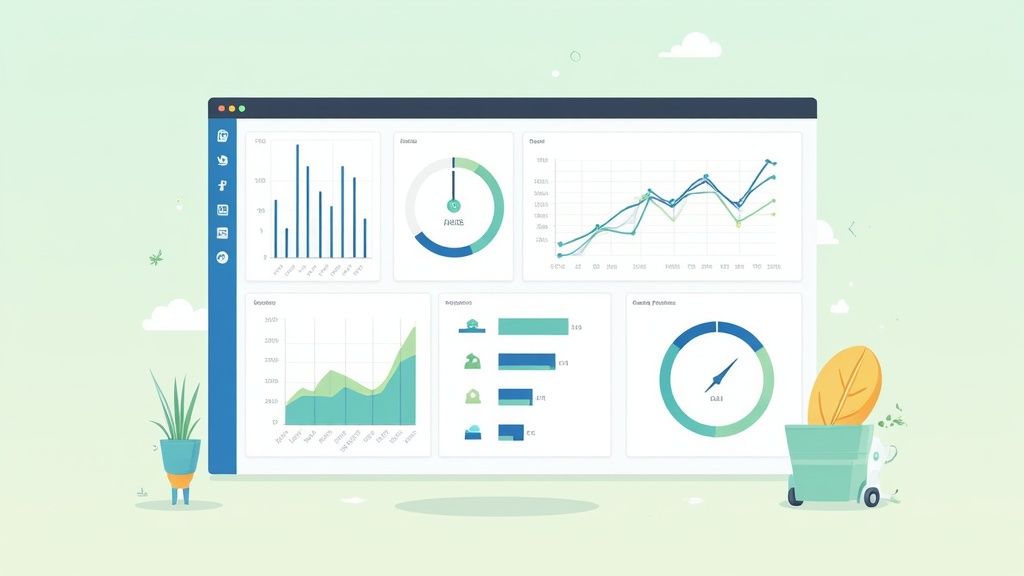Tired of drowning in paperwork, chasing down documents, and dealing with the inevitable chaos of manual client, supplier, or partner onboarding? If that sounds familiar, you’re not alone. The good news is that tools like Superdocu are designed to pull you out of that administrative mess and create a smooth, professional operational process for everyone involved.
Why You Should Automate Client Onboarding with Superdocu
Think about the very first impression you make on a new client, vendor, or employee. That initial operational experience really sets the stage for your entire working relationship. When onboarding feels clunky—a messy trail of emails, endless signature chasing, and manual data entry—it can make your business look disorganized right from the start. This process isn't just a box to check; it's a critical moment that impacts your efficiency and, more importantly, your new contact's trust in you.
Manual onboarding is a minefield of potential problems. Every step, from gathering basic company information to getting a signature on an NDA, is a chance for something to go wrong. A simple typo or a forgotten attachment can hold up an entire project and damage your reputation before you've even had a chance to show them what you can do.
The Real-World Cost of Manual Workflows
Relying on old-school manual methods isn't just slow—it's surprisingly expensive when you add up the lost time. Think about all the hours your team sinks into repetitive, low-value tasks:
- Playing email tag just to get back a signed contract or tax form.
- Copying and pasting information from PDFs into your CRM or spreadsheets.
- Answering the same question over and over: "Did you get my documents?"
All this busywork pulls your people away from what they should be doing: building relationships and delivering amazing results for your clients. The hidden costs of lost productivity and fixing avoidable errors add up fast. Digging into document workflow automation really drives home why making this change is a smart business move.
It's not just a hunch. A study by Wyzowl found that over 90% of customers feel that companies could improve their onboarding process. This is a huge opportunity to stand out from the competition by delivering a seamless, professional experience from day one.
How Superdocu Changes the Game
This is where a purpose-built platform like Superdocu comes in. It’s designed from the ground up to automate the entire process of bringing a new contact into your business ecosystem. Instead of a messy, confusing email chain, you give your new collaborator a single, secure, and branded portal where they can submit everything you need in one go.
The Superdocu interface makes requesting and collecting documents simple for both you and your contacts.

This clear, central dashboard gives you a quick, at-a-glance view of where everything stands, completely eliminating the need for manual tracking and follow-ups.
To see the difference clearly, let's compare the old way with the new way.
Manual vs Automated Onboarding with Superdocu
| Onboarding Aspect | Manual Process | Automated with Superdocu |
|---|---|---|
| Time Investment | Hours of administrative work per contact (emails, data entry, follow-ups). | Minutes to set up; the system runs on its own. Reclaim 5-10 hours per week. |
| Collaborator Experience | Confusing and frustrating. Multiple emails, unclear status, potential delays. | Simple, professional, and transparent. A single portal for everything. |
| Accuracy & Errors | High risk of human error from manual data entry and missed documents. | Data is captured accurately and validated automatically. Required fields prevent incomplete submissions. |
| Tracking & Visibility | Relies on spreadsheets or memory. It's easy to lose track of what's been received. | A real-time dashboard shows the status of every request instantly. |
| Cost | High hidden costs from wasted employee time, error correction, and potential client churn. | Low monthly fee. High ROI from increased efficiency and improved business relationships. |
The table really spells it out. Moving to an automated system isn't just an upgrade; it's a fundamental shift in how you operate, saving you time and making you look good in the process.
Automation has become a go-to strategy for smart businesses looking to work more efficiently. Companies that adopt these tools see massive improvements by letting the system handle the tedious work, like sending reminder emails and checking for document completion. This frees up your team to focus on what humans do best: building great collaborative relationships. By putting a system like Superdocu in place, you’re not just saving time—you’re delivering a polished experience that builds confidence from the moment you say "hello."
Blueprint Your Ideal Onboarding Workflow

Before you can automate client onboarding, you need a solid plan. I see people jump straight into the software all the time, eager to build their workflow. But trying to automate without a clear map is like trying to build a house without a blueprint—it’s just going to get messy.
The first, and honestly most critical, step is to sit down and outline every single action and touchpoint in your process. This isn't just about being efficient. It's about creating a reliable, repeatable system that delivers a professional experience every single time a new client, supplier, or employee joins you.
Think of it as creating a recipe. You're listing every ingredient (documents, information) and every step (internal tasks, messages to the contact) in the exact right order. This blueprint becomes the instruction manual for your automated workflow in Superdocu, making sure nothing important ever falls through the cracks.
Identify Every Document and Data Point
Let's start with what you need from your new contact. Make a complete list of everything you need to collect from a new client, supplier, or partner. And I mean everything. Don't just think about the obvious stuff; consider all the different types of collaborations you handle.
Your inventory should include items like:
- Legal Agreements: Think contracts, NDAs, and your Terms of Service.
- Financial Forms: This includes tax forms (like a W-9), banking details for payments, and billing contact info.
- Project Specifics: What are the project goals? Who are the key stakeholders? Do you need brand guidelines or access to their systems?
- Contact Information: Get the main points of contact, any emergency contacts, and a list of team members you'll be working with.
Getting this list right from the start is fundamental. A recent study found that for 63% of customers, the onboarding experience is a major factor in their buying decision. When you ask for everything in an organized way, you immediately signal that you're a professional who has their act together.
The real goal here is to kill the "oh, just one more thing…" email. By front-loading all your requests into a single, structured process, you show respect for your contact's time and make your company look exceptionally organized.
Map Out Your Internal Tasks
Okay, so you’ve mapped out everything you need from the client or vendor. Now, let’s turn the focus inward. What actually happens inside your company after a contact sends over their information? This is where you'll find huge time savings through automation.
List every single task your team needs to do, in order. For instance, when that contract gets signed, what’s the next domino to fall?
- Does the finance team get a notification to set up billing or payment?
- Is a project manager automatically assigned?
- Does the new contact need user accounts created in your software?
- Should someone on your team be prompted to prepare a welcome kit?
Mapping your internal process is just as important as the external-facing side. Once you define these steps, you can set up automatic triggers in Superdocu to assign tasks and notify the right people at the right time. This completely removes the need for manual check-ins and follow-ups.
For a deeper dive into the principles behind a great process, our guide on client onboarding best practices is a great resource. It's also helpful to understand foundational SaaS onboarding best practices, as many of those operational concepts apply here. With your complete blueprint in hand, you're finally ready to build.
Build Your Automated Onboarding Machine in Superdocu

With a solid blueprint in hand, it’s time to move from planning to action. This is where we get our hands dirty and actually automate client onboarding using Superdocu. We’re going to walk through a common real-world scenario to make this tangible: onboarding a new freelance consultant.
This practical approach will show you exactly how to turn your workflow map into a living, breathing system. Forget about chasing people down with endless emails and manual follow-ups. Let's build your onboarding machine.
Creating the Foundation: A Secure Contact Portal
First things first, every new client, supplier, or partner needs a dedicated, secure space. In Superdocu, you'll start by creating a new "Request". Think of this as the main project folder for this specific onboarding.
For our example, I’d name it something clear, like "Jane Doe – Marketing Consultant Onboarding." This instantly gives you an organized hub for everything related to Jane.
This portal becomes the single source of truth. It's where your new consultant will submit every document and piece of information you need, which is far more secure and less confusing than digging through email attachments.
Configuring Automated Forms and Document Requests
Now, let's start adding the actual tasks to this portal, based on the blueprint you designed earlier. Your map probably has a list of information and specific documents you need to collect.
Let's see what this looks like for our consultant scenario:
- Automated Forms: Instead of emailing a clunky Word doc, you can build a clean Superdocu form to capture key details. I always add fields for their business name, address, tax ID, and banking information. Pro tip: make the most important fields mandatory to ensure you get everything you need in one shot.
- Document Requests: Next, add specific placeholders for every file you need. For our consultant, this would mean creating upload spots for their signed contract, NDA, certificate of insurance, and W-9 form.
A huge part of a smooth onboarding process is knowing how to automate document generation for things like contracts and welcome letters. When you pair that skill with Superdocu's collection features, you create a truly seamless experience from start to finish.
My Favorite Tip: Use Superdocu's templating feature. Once you've perfected this freelance consultant workflow, save it as a template. The next time you bring on a new consultant, you can launch the entire process with a single click. It's a massive time-saver.
Setting Up Intelligent Reminders and Internal Tasks
A truly automated system should do the nagging for you. One of the most powerful things you can set up is the automated reminder schedule. You can configure Superdocu to send polite-but-persistent follow-up emails if your consultant hasn't submitted their files by the due date.
But automation isn’t just for your external contacts. You can also build in steps for your own internal team.
Here are a couple of internal triggers I often set up:
- Task Assignment: Once the consultant submits their signed contract, you can have a task automatically pop up for your project manager to schedule the kickoff call.
- Team Notifications: When the banking details form is completed, you can trigger an automatic notification to your finance department to add the new vendor to your payment system.
These small, automated handoffs are what prevent things from falling through the cracks. They keep the whole onboarding process moving forward without anyone needing to manually check in. For even more ideas, check out our detailed guide on client onboarding automation.
By putting these pieces together, you've officially turned a static checklist into a dynamic, interactive system. You've built a machine that not only collects what you need but also guides your new partner, assigns internal work, and keeps everyone perfectly in sync.
Make Your Client Onboarding Unforgettable with Smart Automation

Let's be honest, good automation isn't just about making your team's life easier. It’s about creating a genuinely better experience for your new client, supplier, or partner. Once you've got your basic onboarding workflow set up in Superdocu, it's time to add the intelligent touches that take the process from "good enough" to "wow." This is how you automate client onboarding so it feels personal and attentive, not like a robot took over.
The real goal here is to use tech to build a stronger human relationship. When you automate the tedious paperwork and follow-ups, you free up your team to have meaningful, strategic conversations with new contacts. It's all about building trust and showing them they're valued right from day one.
Use Conditional Logic to Ask Smarter Questions
One of my favorite features in Superdocu is conditional logic. This is the secret to creating dynamic forms that adapt on the fly based on what a contact tells you. Instead of hitting every single person with a massive, one-size-fits-all questionnaire, you can tailor the experience in real time.
For instance, say your first question is, "What is the nature of our collaboration?"
- If they pick "New Vendor," the form can instantly reveal follow-up questions about their payment terms and tax information.
- If they choose "Client Project" instead, it can ask about their project goals and key stakeholders.
This isn't just clever; it makes the entire process feel more intuitive and respectful of the person's time. They only see what's relevant to them, which immediately makes your company look sharp and considerate. To dig deeper into this, check out our guide on document workflow automation for more ideas.
Trigger Personalized Messages at Key Milestones
Automation should never feel cold or distant. With Superdocu, you can set up personalized messages to send out automatically as contacts hit important milestones in their onboarding. This creates a guided journey that keeps them in the loop and feeling confident.
Imagine setting up these simple, automated touchpoints:
- A Warm Welcome: The moment they start the process, send an email that says, "Welcome aboard, [Contact Name]! We’re so excited to get started with you."
- Quick Confirmation: Right after they sign their contract, another email can confirm you've received it and briefly outline what happens next.
- A Final "Hooray!": When all their onboarding documents are in, a final message can celebrate that they've completed the process and introduce them to their main point of contact.
This is more than just being efficient. It’s about making your new partner feel seen and supported. A well-timed, personal message shows you’re on top of your game and genuinely care about their experience.
Focusing on a better collaborator journey is non-negotiable. In competitive fields, a huge number of businesses are looking for solutions that make them more productive, and most professionals see automation as essential. Yet, even with great tools, companies constantly struggle to build strong relationships long-term. This is where personalizing your automated flows can be the key to securing that collaboration.
Measure and Optimize Your Onboarding Performance
Alright, so you’ve built your automated workflow in Superdocu. That’s a huge win, but don’t make the mistake of thinking it’s a “set it and forget it” deal. The best systems I’ve ever seen are the ones that are treated like a living, breathing part of the business—constantly being tweaked and improved with real data.
Your Superdocu dashboard is more than just a place to see who has done what. It’s a treasure trove of insights. By actually looking at the numbers, you can stop guessing and start making smart, data-backed decisions that make life easier for everyone involved. We’re not talking about massive overhauls here. It’s the small, informed adjustments that lead to a faster, smoother, and more professional experience for your new contacts.
Key Onboarding Metrics to Monitor in Superdocu
So, what should you actually be looking at? Superdocu gives you all the data you need to see what’s working and what’s hitting a snag. I recommend focusing on a few key metrics that tell the real story of your process.
Here’s what I always keep an eye on:
- Time-to-Complete: On average, how long does it take a new contact to get from start to finish? This is your big-picture efficiency number.
- Individual Step Duration: Which specific forms or document uploads are taking the longest? This is usually where you'll find confusing instructions or a form that's just too complicated.
- Document Submission Rates: Are contacts getting everything done in one session, or are they having to come back multiple times? If it’s the latter, your process might feel overwhelming.
- Common Bottlenecks: Where do people get stuck? Your dashboard will clearly show you which tasks are lagging, pointing directly to the biggest friction points in your workflow.
Tracking these numbers helps you build a habit of continuous improvement. You start to see patterns and can begin asking the right questions.
A Simple Framework for Data-Driven Optimization
Once you have the data, you can use a simple loop to turn those insights into real improvements: find the problem, try a fix, and measure to see if it worked.
Let’s walk through a real-world example. Say you notice the "Company Information" form consistently takes a full week to submit, holding everything else up.
- Figure Out the "Why": Is the form too long? Are the questions vague? Is it asking for information they don't have yet?
- Try a Small Tweak: You could break it into a few smaller, more focused questions. Or maybe add some clear examples to guide them.
- Make the Change in Superdocu: Jump in and update that form template. It only takes a few minutes.
- Measure Again: Keep an eye on the Time-to-Complete for that specific step with the next batch of new contacts. Did your change actually speed things up?
You can't improve what you don't measure. Regularly checking your onboarding data in Superdocu is what separates an automated system from an optimized one.
This cycle of analyzing and refining is how you truly get ahead. The companies that are serious about tracking these kinds of metrics gain a massive advantage because they can spot drop-off points and fix them before they become bigger problems. If you skip this part, you're just relying on gut feelings instead of hard data, and that’s a huge missed opportunity. If you want to go deeper, you can discover more about using data for onboarding automation and see how powerful this approach can be.
Got Questions? We’ve Got Answers.
When you start thinking about automating your operational onboarding, it's natural for a few questions to pop up. We get it. You want to be sure you're making the right move. So, let’s tackle some of the most common things people ask us before they dive in with Superdocu.
How Tech-Savvy Do I Need to Be?
Honestly, not very. We built Superdocu for business people, not coders.
If you can sketch out your contact onboarding steps on a piece of paper or a whiteboard, you have all the technical skill you need. Our interface is drag-and-drop simple, and we have plenty of pre-built templates to get you started. You won't be writing any code or dealing with complex configurations. It’s all about making powerful automation easy for everyone.
Can I Have Different Onboarding Flows for Different Types of Contacts?
Yes, absolutely! This is one of the best parts about using Superdocu. You’re not stuck with a rigid, one-size-fits-all process.
In fact, you can create and save as many workflow templates as you want. For example, you could have:
- A comprehensive onboarding process for your big enterprise clients.
- A quick and easy workflow for your smaller business accounts.
- A totally separate checklist for bringing on new suppliers or vendors.
- A dedicated flow for new employee document collection.
This flexibility means everyone you work with gets an experience that feels like it was made just for them.
The Big Picture: Superdocu's real strength is its adaptability. You can design the perfect journey for any business relationship—clients, partners, even new employees—all from a single, organized platform.
Is It Actually Safe to Handle Sensitive Documents This Way?
We know that handling sensitive information is a huge responsibility. That's why security is baked into the very core of Superdocu, not just added on as an afterthought.
Every document is protected with enterprise-grade, end-to-end encryption. This applies when a file is being uploaded and while it’s stored on our servers. Think about the usual alternative: emailing sensitive attachments back and forth. Email is notoriously insecure and prone to human error—like accidentally sending a confidential file to the wrong person. A secure, centralized portal like Superdocu eliminates that risk entirely.
Ready to stop chasing paperwork and start delivering a seamless onboarding experience? With Superdocu, you can build an automated system in minutes, not months. See for yourself how easy it is to save time, cut down on errors, and impress every new contact from the very beginning. Start your free trial of Superdocu today.
